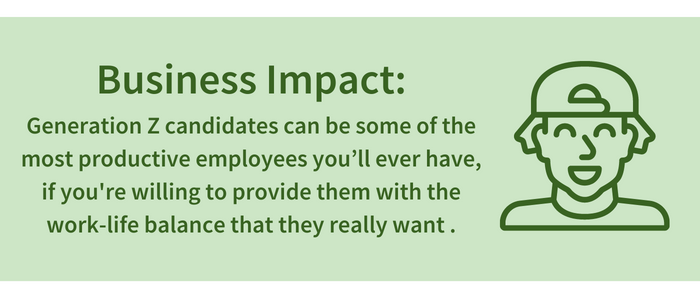Understanding the New Generation of Workers

How to Get Gen-Z in the Door and Keep Them
With the Great Resignation in full swing and Baby Boomers retiring in droves, the time has come to focus on attracting and retaining a new generation of workers. Of course, to effectively employ Gen Z candidates, we need understand what makes them different and what they value.
Why do I want to employ Gen Zs in the first place?
Born between 1997 and 2012, your median Gen Z candidate was born around the same time YouTube was invented. Many have been on the internet and utilizing online tools since before they could walk. Their familiarity with digital technology has made them incredibly efficient at computerized tasks, often producing in 30 hours what prior generations could do in 40. It’s a good thing too, because most don’t want to work 40 hours per week, let alone overtime. Gen Z covets work-life balance and mental wellness. Measure their performance by how much time they spend in the office at your own peril. Measure them by how much work they get done and we think you’ll be pleasantly surprised. Their efficiency combined with their entrepreneurial drive and desire to innovate can be a powerful force for your organization.
So how do I get them in the door?
It’s simple when you think about it. Employers just need to go through the one thing every Generation Z candidate has in their hand right now… their cell phones. Social media and quick connecting will be essential when it comes to hiring the new generation. Reviewing your recruitment process to ensure HR is connecting with candidates fast in order to keep Gen Z candidates excited and eager for your opportunity. Another theme among Gen Z recruitment is the importance of referrals. Whether it be taking makeup recommendations from Youtubers or reading reviews on Amazon, Gen Z relies heavily on referrals from others on their decision making. This applies to their job hunting as well. HR professionals should utilize their current employees to help attract talent. Whether is it through referral programs or having them active on your company’s social media platforms. This will help shed some light into the true work experience for the incoming employees.
We hired them but, how do we retain them?
Admittedly, this is the hard part. Gen Z likes to job hop… a lot. In many ways, the internet has made their world a lot smaller, and they will quickly become aware if your compensation and benefits aren’t keeping pace with other employment opportunities. If you don’t want to constantly be in a bidding war for top talent, there are a couple of things to keep in mind.
First, transparency is imperative when it comes to their employee life cycle. Gen Z will be looking for a clear understanding of their potential growth path within your organization as well as what the expectations are of their role. They want their employers to be honest and communicative about their future in the organization. Consider mentorships or even job rotation, not just so they are better trained, but so that they feel like you are investing in them.
Second, remember that whole work-life balance thing we talked about. It is by far the most cost-effective way to retain the new generation. Remote work, flexible scheduling, Summer Fridays, and mental health days are all ways to show that you value them as human beings who have lives outside of the office. Many are willing to make a bit less money if it means they’ll have the time to pursue their other passions.
While Gen Z is bringing technology, remote work, and entrepreneurial spirit into the workforce, the biggest takeaway is they are looking for their employers to provide an open, honest, and flexible work environment. Gen Z has a lot to offer the workforce and if employers understand the differences, they’ll be able to maximize the benefits of their presence.
Written by
Gabriella Pereira

